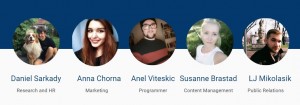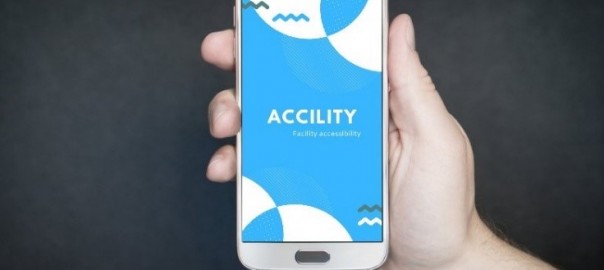Imagine you are a tourist in Salzburg, travelling with a group of friends. You have been out for a long walk in the morning, where you firstly went up to Hohensalzburg and afterwards strolled along the Salzach.

(Source: pixabay.com)
You all took lots of pictures, and now most of you are getting hungry and are ready to find something to eat. However, you also need to have WiFi to share the pictures with your families, and you would need to charge your phones in order to keep on taking pictures in the afternoon without having to go to your hotel to charge. In addition, one of your friends is vegetarian.
You start scrolling through various Google results, and usually it is easy to see whether a place has WiFi or not or even vegetarian food, however to see if they have plugs accessible, requires some more thorough investigation, and you become impatient.
That’s when your friend shows you Accility.

(Source: mockup.photos.com)
Accility allows you to search for the amenities that your group needs. Your friend shows you how he searches for cafès and restaurants which offers WiFi, plugs and vegetarian food, and he instantly finds the closest place that offers all three of them. Super simple, super convenient.
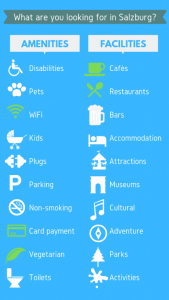
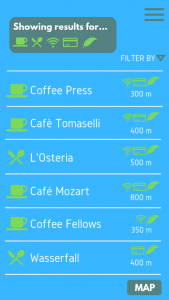
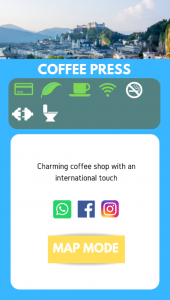
You and you friends use the map-function to quickly navigate to Coffee Press which offers everything you need, and more. The map-function lets you further, easily identify specific amenities that you need with a traffic light system similar to the one in the picture below. Green are attractions that have all desired amenities, orange those who have most of them, red are the ones with no selected amenity.
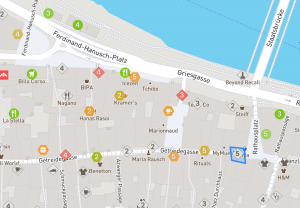
(Source: Wheelmap.org)
How did we come up with Accility?
The idea of Accility emerged after efficient market research with tourists who had problems regarding the time-consuming research needed when they were in need of specific amenities in a destination. Some things are easy to find through Google or TripAdvisor, such as WiFi, vegetarian options etc., however the frustration occurs when they are in need of more than one amenity, and they need to look through a variety of websites and perhaps end up calling instead.

(Source: Pixabay.com)
After identifying the problem, we brainstormed ways to solve it. Our solution needed to be time-efficient and user-friendly. We tried different solutions, did rapid prototyping and adjusted our solution according to the feedback we got along the process. We had to eliminate things like AR, Premium functions and verification in order to really simplify it and make it affordable. These are ideas we keep in mind for the future if the app proves to be successful. We want to keep it simple and convenient – because scrolling through thousands google pages isn’t. We want to make our app easy to use and simple to understand, with symbols and only the most relevant information so users don’t get frustrated when using it.
Future opportunities
One threat is the short usage time-span in the beginning, as tourists in Salzburg will only need it for a short period, and locals will shortly learn which places have the amenities they typically need and therefore might not feel like they need the app anymore. Profitability is low due to the only revenue generated is from advertising within the app. This will be especially challenging in the beginning when the app will only be available for use in Salzburg.
The problems of app-usage-time will somehow be solved when we expand to several destination and the user will need/want to have the app in his/her phone for longer as they will be able to use it in other destinations as well. With increasing popularity of the app, in order to increase profitability, we also have an opportunity to develop and offer a premium-function where premium users have the possibility to discover the cafes/restaurants/attractions they need using AR technology. Our advantage is the immense market-size of Austria, Germany and Switzerland. Over 70 Million tourists annually are visiting these countries. If only a small portion of those use our app we could be successful over a long period of time, and in this calculation we do not even include the local users.
Critical reflection:
Our app has the possibility to make navigation to the right places within a destination very time-efficient and hustle-free. Some critique has been directed to us due to the fact that Google and Tripadvisor offer some of the same information regarding a small selection of amenities, and this is a clear threat for us which means that we need to differentiate us in being significantly easier to use and understand. With Accility we strongly believe that both tourists, students and locals will take advantage of it. We offer a larger number of amenities than our competitors, the process of finding them in the destination is easier and we are the only ones providing a simple app-solution focused on filtering the amenities by relevance and distance from your location. As any start-up need to be, we are prepared for pivoting and to implement new ideas when the market shows need for it. With the DMO’s in cooperation we will assure that the information is always up to date and increase the overall destination image by urging attractions to update their own amenities. We always like to recall our Win-Win-Win situation. A win for tourists who benefit of the simplicity of finding what they need, a win for the attractions who benefit of attracting their target market, and a win for the destination who ultimately increases its destination image.
